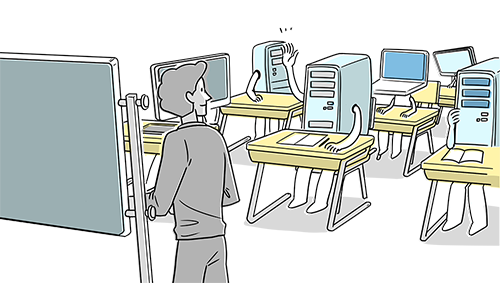Machine learning
Machine Learning technology (MLT) is a term used to describe various types of Artificial Intelligence (AI) technology in which a computer program has the ability to modify itself. This self-modification can take the form of self-improvement, or error-detection, and is implemented in various ways. Machine Learning scientists are concerned with the question “How can we program a machine to automatically learn and to improve with experience?” To do that they develop special algorithms based on statistical and computational principles to address the learning processes that characterize the fundamental nature of experience in learning. Basically there are two major approaches: The supervised and unsupervised learning.
Supervised learning in machine learning technology consists of a selected set of data and rules that the software program must follow to get to the correct patterns. The program must manipulate the input data in order to fit the patterns given by the programmers and make adjustments as directed by the programmer. In unsupervised learning, the software is given the set of data, and patterns, but must make adjustments without direction. The program essentially learns by trial and error, without human intervention.
The combination of supervised and unsupervised learning algorithms can be used to improve the ability of an AI program so the machine can learn faster and be able to come up with correct results. From these algorithms, it is possible to develop software that can operate machine and be able to self correct when it makes mistakes. These software products are now being used in many factories and built into large to small machines for better performance and accuracy. Another application of this software is used to recognize human speech such as instructions. For example speed recognition software in mobile phone. It is expected that in the next few years with speech recognition technology, people can talk to computer without have to use keyboard or mouse.
In addition to supervised and unsupervised machine learning algorithms, machine can also learn by reinforcement. This method starts by having the machine observe an example of how the task is done and have it repeats each step. Reinforcement learning provides positive and negative feedback to the program as it learns, allow it to improve performance and correct itself. This technique is used mostly in robotics industry.
Today machine learning is a key part of the artificial intelligence field with many useful applications. For example machine learning techniques are used to predict which medical patients will respond to which treatments by analyzing databases of medical records. Machine Learning algorithms are applied in robots and enable them to learn how to move around obstacles based on experience they gather from sensors. Machine learning algorithms are used in computer aids for scientific discovery that combine scientific hypotheses with experimental data to automatically produce refined scientific hypotheses that better fit observed data. For example call centers use voice recognition, data mining operations to search for information, and reduces the amount of time necessary to refine computer programs. The essential function of these programs is to find ways to reduce the need for human involvement, through the increased abilities of the machines.
The question often asked is: “Can machine replace people?” The correct answer is: “Machine can do the work of people more effectively, efficiently, and accurately but it still needs people to program it. It will learn to correct its mistakes and think of the best approach to solve problems but it still have to be programmed by people. Without machine learning algorithms built-in, machine cannot function. As more robots are being built, as more intelligent machines are being used the need for software people who can design and program machine learning algorithm is also increased significantly.
Sources
- Blogs of Prof. John Vu, Carnegie Mellon University
